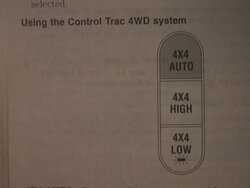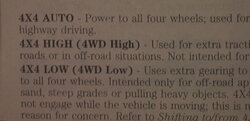OK, to recap (seeing as I started this thread), this is what I've figured out from what I have read here and elsewhere:
2WD = rear wheels drive only
4WD High = All four wheels receive power, no center differential, usable on mud/snow only
4WD Low = All four wheels receive power with reduction in the transfer case, no center differential, usable on mud/snow only
4WD Auto/Control-Trac = 2WD unless truck detects slippage between front and rear wheels. When slippage is detected, truck starts engaging 4WD clutch in transfer case on and off quickly to send power to the front wheels as well. Clutch is cycled instead of just engaged continuously to allow for front wheels to travel further in turns on dry pavement without binding up the driveline, due to a lack of center differential. Duty cycle (time clutch engaged vs time clutch disengaged) varies - with lots of slippage between front/rear wheels, clutch spends more time engaged. As traction improves, clutch spends more time disengaged.
Advance-Trac = Control-Trac with the ability of the truck to apply brakes to individual wheels to assist with traction.
Advance -Trac with RSC = adds gyro's to the system. When it detects excessive body roll, it applies braking force to individual wheels to prevent roll-over.
AWD = Means anything the manufacturer decides it means. Can mean:
All power sent to one set of wheels until slippage detected, in which case some torque sent to other set of wheels (i.e. Honda CR-V)
All power sent to all four wheels simultaneously through limited slip and/or lockable center differential (i.e. Subaru)
All power sent to all four wheels simultaneously through viscous coupling
Any other system that sends power to more than just two wheels









